Biden's New Student Loan Payment Plan Has Arrived. Here's What That Means.
Biden's new income-driven repayment plan is estimated to cost taxpayers $360 billion over the next decade.

Applications are now open for a new student loan repayment program which will cost taxpayers billions and turn most federal loans into glorified grants.
The SAVE plan is a revamped income-driven repayment (IDR) plan, introduced last year along with President Joe Biden's original student loan forgiveness scheme—though that proposal was struck down at the Supreme Court in June. While the SAVE plan received less attention than Biden's now-defeated student-loan forgiveness proposal, it stands to do nearly as much long-term damage to taxpayers—and prospective student loan borrowers themselves.
Under the REPAYE plan, the most popular IDR plan currently in use, borrowers' monthly payments are typically fixed at 10 percent of their discretionary income. Discretionary income is calculated as earnings above 150 percent of the federal poverty level. Under this plan, borrowers will have their remaining balance forgiven after 20 years of on-time payments, or 25 years for graduate borrowers.
But the SAVE plan radically reduces monthly payments—and the time required before forgiveness. Under the plan, borrowers only pay 5 percent of discretionary income, which is now defined as earnings above 225 percent of the poverty rate. Borrowers only have to make 10 years of payments before forgiveness, if the balance is less than $12,000. Further, interest will not accrue on borrowers' loan balances when their monthly payments are not enough to cover interest.
According to an analysis from the Penn Wharton Budget Model, the new plan is expected to cost around $360 billion over the next decade—a staggering price tag, though not quite as much as the over $500 billion predicted cost of one-time student loan forgiveness.
But the new IDR plan won't just cost taxpayers an absurd amount of money. It will also make college even more expensive than it already is. In making student loan payments minimal or nonexistent for large swaths of borrowers, colleges will be incentivized to raise their prices, extracting more funding out of the government through loans, all while assuring prospective students that they won't feel the financial burden of a large student loan balance.
Currently, undergraduate programs are at least somewhat constrained in how much they can charge because of a cap on federal student loan borrowing for undergraduate degrees. However, there is no similar limit on graduate borrowing, meaning that graduate schools can instruct students to borrow virtually infinite sums of money from the government—and encourage them to enroll in a SAVE plan to pay it all off.
The introduction of the SAVE plan serves as both an admission of failure and as an inability to right past policy errors. Colleges began radically increasing prices due to the expansion of federal student loan availability over the past several decades. Graduate tuition increases have also been directly linked to the removal of the cap on federal student loan borrowing in 2006.
Instead of doing the obvious—curbing federal student loan access—the Biden administration has asked taxpayers to foot the bill for past policy mistakes, accepting a future where higher education costs more than it should.



Show Comments (30)